Wellaholic Research: Randomized Controlled Trials on Teeth Whitening
Delve into Wellaholic's groundbreaking research on teeth whitening! Discover intriguing insights from randomized controlled trials that could revolutionize your smile. Embrace a brighter, whiter smile today!
Read More






